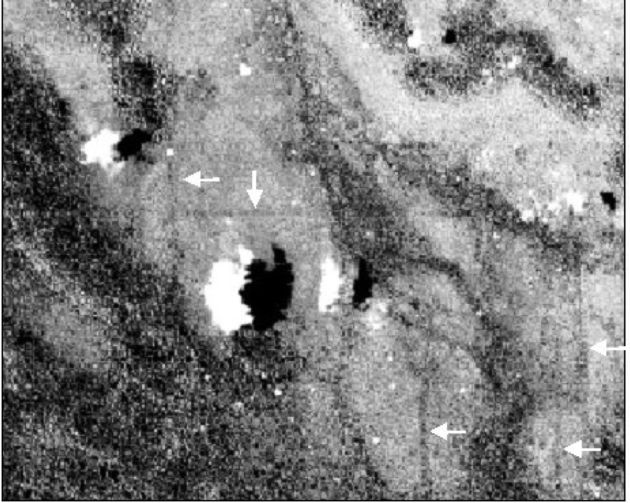Ancient Mayan Canals Possibly Spotted in Satellite Images

Where the rain forests of Guatemala now stand, a great civilization once flourished. The people of Mayan society built vast cities, ornate temples, and towering pyramids. At its peak around 900 A.D., the population numbered 500 people per square mile in rural areas, and more than 2,000 people per square mile in the cities -- comparable to modern Los Angeles County.
This vibrant "Classic Period" of Mayan civilization thrived for six centuries. Then, for some reason, it collapsed.
The fall of the Maya has long been one of the great mysteries of the ancient world. But it's more than a historical curiosity. Within sight of the Mayan ruins, in the Pet?n region of Guatemala near the border with Mexico, the population is growing again, and rain forest is being cut to make farmland.
"By learning what the Maya did right and what they did wrong, maybe we can help local people find sustainable ways to farm the land while stopping short of the excesses that doomed the Maya," says Tom Sever at the Marshall Space Flight Center (MSFC).
Sever, NASA's only archeologist, has been using satellites to examine Mayan ruins. Combining those data with conventional down-in-the-dirt archeological findings, Sever and others have managed to piece together much of what happened:
From pollen trapped in ancient layers of lake sediment, scientists have learned that around 1,200 years ago, just before the civilization's collapse, tree pollen disappeared almost completely and was replaced by the pollen of weeds. In other words, the region became almost completely deforested.
Without trees, erosion would have worsened, carrying away fertile topsoil. The changing groundcover would have boosted the temperature of the region by as much as 6 degrees, according to computer simulations by NASA climate scientist Bob Oglesby, a colleague of Sever at the MSFC. Those warmer temperatures would have dried out the land, making it even less suitable for raising crops.
Sign up for the Live Science daily newsletter now
Get the world’s most fascinating discoveries delivered straight to your inbox.
Rising temperatures would have also disrupted rainfall patterns, says Oglesby. During the dry season in the Pet?n, water is scarce, and the groundwater is too deep (500+ feet) to tap with wells. Dying of thirst is a real threat. The Maya must have relied on rainwater saved in reservoirs to survive, so a disruption in rainfall could have had terrible consequences.
(Changes in cloud formation and rainfall are occurring over deforested parts of Central America today, studies show. Is history repeating itself?)
Using classic archeology techniques, researchers find that human bones from the last decades before the civilization's collapse show signs of severe malnutrition.
"Archeologists used to argue about whether the downfall of the Maya was due to drought or warfare or disease, or a number of other possibilities such as political instability," Sever says. "Now we think that all these things played a role, but that they were only symptoms. The root cause was a chronic food and water shortage, due to some combination of natural drought and deforestation by humans."
Today, the rain forest is again falling under the axe. About half of the original forest has been destroyed in the last 40 years, cut down by farmers practicing "slash and burn" agriculture: a section of forest is cut down and burned to expose soil for planting crops. It's the ash that gives the soil its fertility, so within 3-5 years the soil becomes exhausted, forcing the farmer to move on and cut down a new section. This cycle repeats endlessly ... or until the forest is gone. By 2020, only 2 percent to 16 percent of the original rain forest will remain if current rates of destruction continue.
It seems that modern people are repeating some of the Maya's mistakes. But Sever thinks disaster can be averted if researchers can figure out what the Mayans did right. How did they thrive for so many centuries? An important clue comes from space:
Sever and co-worker Dan Irwin have been looking at satellite photos and, in them, Sever spotted signs of ancient drainage and irrigation canals in swamp-like areas near the Mayan ruins. Today's residents make little use of these low-lying swamps (which they call "bajos," the Spanish word for "lowlands"), and archeologists had long assumed that the Maya hadn't used them either. During the rainy season from June to December, the bajos are too muddy, and in the dry season they're parched. Neither condition is good for farming.
Sever suspects that these ancient canals were part of a system devised by the Maya to manage water in the bajos so that they could farm this land. The bajos make up 40 percent of the landscape; tapping into this vast land area for agriculture would have given the Maya a much larger and more stable food supply. They could have farmed the highlands during the wet season and the low-lying bajos during the dry season. And they could have farmed the bajos year after year, instead of slashing and burning new sections of rain forest.
Could today's Pet?n farmers take a lesson from the Maya and sow their seeds in the bajos?
It's an intriguing idea. Sever and his colleagues are exploring that possibility with the Guatemalan Ministry of Agriculture. They're working with Pat Culbert of the University of Arizona and Vilma Fialko of Guatemala's Instituto de Antropolog?a e Historia to identify areas in the bajos with suitable soil. And they're considering planting test crops of corn in those areas, with irrigation and drainage canals inspired by the Maya.
A message from 900 A.D.: it's never too late to learn from your ancestors.









